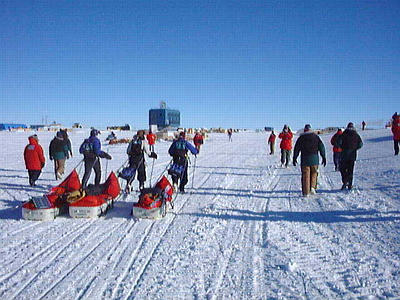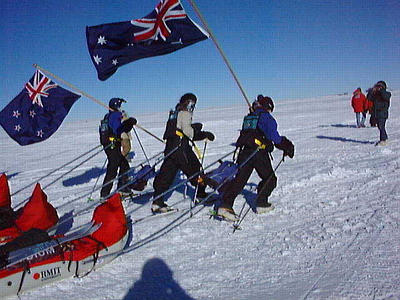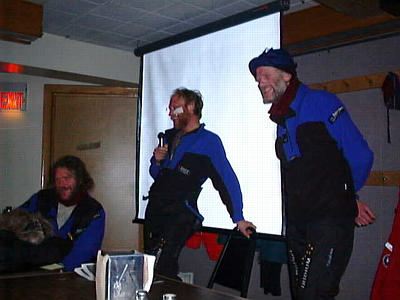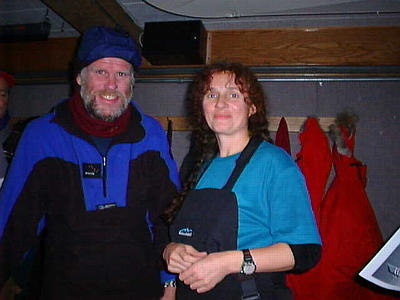26 January, 1999
Tuesday, January 26th, 1999, South Pole Station.
Dave left at 10a.m, as planned, however, I could not see them off
because I had my first session of CUSeeMe, a life video-conference,
with several schools.
I met Bob in the galley at 7a.m. and we skied to the Dark Sector of
the station. I was thrilled, that we made an instant connection and I
was able to see people on the other end on my computer and also talk
to them over 9000 miles away from me. The voice communication did not
work out so well and we communicated with one another via writing.
Exciting. Unfortunately, we lost the connection due to satellite
problems after 15 minutes. We will try again tomorrow same time: 8a.m
local time, 2p.m. New York time. It any of your schools has a CUSeeMe
program set up, please let me know. We might be able to set up a
conference if the satellites cooperate. We had some problems receiving
the signal. However, if it would work out too perfectly we would not
be able to believe that I am at the South Pole. Right?
I asked yesterday if we observe an overall depletion of the ozone over
the whole Earth or only around the Antarctica and if something has
been done about saving the remaining ozone.
I asked Bryan Johnson and here is what he emailed me back from
McMurdo:
" The question about ozone loss is hard to answer - since ozone is
always being produced and destroyed. The average rate of decline in
total ozone is about 4 to 6% per decade (10 years). I think the
number the students are asking about may be that the total ozone
destroyed over Antarctica in one season represents about 3% of the
ozone in the atmosphere. The main idea to have the students
understand is that ozone is not a limited quantity in the atmosphere
that we are running out of - it is a balance of destruction and
production processes, and when we have excess chlorine in the
stratosphere then we reach a lower level of balance - because
chlorine adds an extra (very effective) destruction process. Ozone is
produced mostly in the equator regions, but the dynamics of wind and
currents transport ozone out of the tropics and to the mid-latitudes
where it tends to build up."
I understood what he said and I hope it will help you as well. The
second question was: What has been done to save the remaining ozone
layer? I answer this very important question tomorrow because I have
to do some reading about it first.
THE ICE TREK TEAM ARRIVED
I was very busy catching up with my emails, answering all those
wonderful questions and preparing tomorrows answer. During the
afternoon we received a very interesting announcement. The ICE TREK
team was spotted by one of the planes and was about 10 miles away from
the pole. What an excitement! Throughout the afternoon we were
informed about their progress. When they were about 2 miles away from
the station I put my skies on and met them outside of the station on
the trail. What an exciting sight! I felt like I met Amundsen and
Scott at the same time. I could actually great an Antarctic team that
had crossed the Antarctic continent for the past 84 days. The team
leader was Peter Hillary from New Zealand. (His father was Sir Edmund
Hillary, a world famous mountaineer, see journal …. ). His comrades
were John Muir, from New Zealand, and Eric Phillips, from Australia.
People from the whole station left their work and came to great them
while they were approaching the Geographic South Pole. It was a very
touching moment to see these men finally reach the Pole after illness,
bad weather and shortage in food. They were in great spirit and looked
very happy. Their time of arrival was 5:15pm, local time. Upon their
arrival at the Pole, I saw John kiss the floor. Touching! They had
reached their pole. I would have loved to know what they were
thinking. We all took lots of pictures around the pole. I could not
get my eyes of them and I was very excited for them.
Within an hour we heard the announcement that they had agreed to give
a lecture to us at 8p.m. How strange it must have been to see so many
people after almost 3 month of total solitude. Needless to say that
the galley was packed with people to listen to their talk:
They started their adventure at the Ross Ice Shelf, went through the
Shackleton Glacier until they reached the Antarctic Plateau. From
there they went to the South Pole. The route they choose was in
between the treks of Amundsen and Scott. It was the longest route to
the South Pole. The team used skies and each one of them pulled a 400
pound sled - attached to their waste - behind them. They lived
together in one two-men tent throughout the time of their journey.
Their favorite part was the Shackleton Glacier and each one of them
would go back there any time. They were the only people who ever
crossed the whole Shackleton Glacier. "Bloody unreal and fantastic" as
John Muir said.
No one had taken their route before and they were not upset that they
did not keep to their schedule. After all, they made it through a
difficult passage and made it to the Pole. Their original plan was to
arrive at the Pole around Christmas in 64 days and then return back to
the Ross Ice Shelf. Bad weather and illness slowed them down. Yet,
they made it. They were asked why they choose such a long and
difficult task. Peter Hillary answered that he loves the time of
isolation and solitude to have time to think, to push himself to the
limit, and to be with comrades. Eric Phillips said that he wanted to
come here ever since he was 12 years old when he saw a picture of the
South Pole Station with its dome and people in red jackets. "It looked
like being on the Mars, like no place on Earth." I agreed…. And he
told himself: " I have to get there!" … and he did.
After their talk, the adventurers made time for all of us to get
autographs and to chat with them on the one-to-one basis. I
appreciated so much that I had the chance welcome such a special group
of people. Tonight I will be dreaming about trekking through ice and
snow in the Antarctic sun. To see the reports and photos of the ICE
TREK team go to: www.icetrek.com.

The ICE TREK team arriving at South Pole Station

The ICE TREK team approaching the Geographical South Pole.

Hillary, Muir, and Phillips, the Ice Trek team, at South Pole Station, the dome is in the background

The Ice Trek team at the Geographical South Pole.

John Muir, Eric Phillips and Peter Hillary (fr.l to r) giving a talk in our galley.

I had a chance to talk to Peter Hillary, the leader of ICE TREK.
Contact the TEA in the field at
.
If you cannot connect through your browser, copy the
TEA's e-mail address in the "To:" line of
your favorite e-mail package.
|
